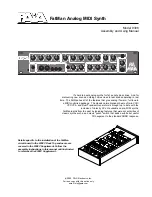
Plonk Manual
v1.01
(resonator)
is
being
used,
notice
that
the
resulting
sounds
are
dramatically
different.
That’s
the
sonic
characteristic
controlled
by
the
Mallet
Stiffness
parameter.
Noise
Density
Controls
the
rate
at
which
the
random
noise
is
generated.
At
lower
values,
individual
clicks
can
be
heard,
which
can
sound
like
particles
hitting
the
surface
of
the
resonator.
Increasing
the
density
will
increases
the
number
of
clicks
generated
in
a
given
interval
of
time
until
the
output
becomes
continuous
white
noise.
With
appropriate
envelope
and
filter
settings,
a
noise
density
between
50
and
100
can
be
good
for
bowed
sounds
or
snares.
Noise
Lowpass
Cutoff
Sets
the
cutoff
frequency
of
the
lowpass
filter
applied
to
the
white
noise
exciter.
Noise
Lowpass
Q
Sets
the
resonance
of
the
lowpass
filter.
Noise
Highpass
Cutoff
Sets
the
cutoff
frequency
of
the
highpass
filter
applied
to
the
white
noise
exciter.
Try
to
keep
this
value
below
that
of
the
Noise
Lowpass
Cutoff.
Noise
Highpass
Q
Sets
the
resonance
of
the
highpass
filter.
Noise
Attack
Sets
the
duration
of
the
attack
stage
of
the
noise
amplitude
envelope.
Noise
Decay
Sets
the
duration
of
the
decay
stage
of
the
noise
amplitude
envelope.
Noise
Envelope
Type
Sets
the
type
of
noise
envelope
used.
Page
14





































